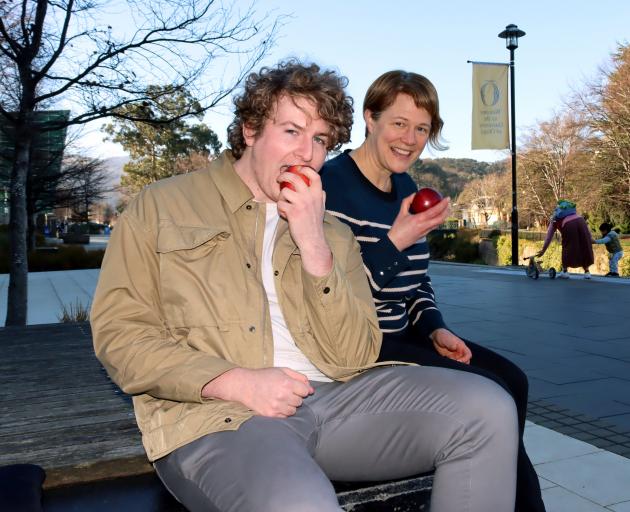Science
Research Unlocks Secrets of Heritage Apple Varieties in New Zealand

A comprehensive study of over 300 apple varieties from the Jim Dunckley Heritage Orchard in New Zealand is underway, led by Aaron Hewson, a master’s student in plant biotechnology. The orchard, established by the Coastal Otago Branch of the New Zealand Tree Crops Association 25 years ago, is recognized as one of the most diverse collections of apple cultivars in the country. These varieties include uniquely named cultivars such as Peasgood Nonsuch, Nonnetit Bastard, Warner’s King, and Albany Beauty.
Mr. Hewson’s research aims to aid in the preservation and propagation of these heritage cultivars through reliable genetic identification. The cultivars were originally collected in the 1990s by Jim Dunckley from various locations across Otago and Southland, with a significant number sourced from Clyde, where an old Plant & Food Research orchard was located. Hewson describes the collection as a “real kind of hodgepodge mix,” noting that some trees bear names given by local farmers that reference landmarks, which may not align with their genetic characteristics.
He pointed out a perplexing case involving a commonly known Plant & Food apple called Granny Smith and another named Lord Lambourne. Genetically, the analysis indicated that these two cultivars might actually be the same despite their distinct names. “So one of those names has to be wrong,” he explained.
To investigate these discrepancies, samples were collected by both university students and staff from the Plant Biochemistry Lab. These samples were freeze-dried, labeled, and subsequently sent to a laboratory in France for genetic analysis, facilitated by the Bioeconomy Science Institute. Mr. Hewson acknowledged the assistance of his co-supervisor, Dr. Elena Lopez-Girona from Plant & Food Research, emphasizing the value of her expertise throughout the research process.
The samples underwent genotyping using a method called SNP chip analysis, which examines approximately 50,000 known DNA hotspots in an apple leaf to produce a genetic fingerprint. This technique is crucial in determining whether two trees belong to the same variety or if they are genetically distinct. Given the stringent biosecurity rules surrounding apple genetics in New Zealand, this local collection could play a vital role in enhancing disease resistance among apple varieties.
Mr. Hewson highlighted the alarming genetic narrowness among commercial apple varieties worldwide. “If we talk about the entire amount of apples across the world, there is something on the order of 10,000 different varieties. But all of our commercial varieties, no matter how many there are, they all come from six apples, so it is really, really narrow,” he stated.
The research also has broader implications for apple breeding in New Zealand. Associate Professor Lynnette Brownfield, Mr. Hewson’s co-supervisor, noted that identifying the genetic makeup of these heritage apples could help breeders uncover new genetic material that might enhance disease resistance and overall diversity in future apple breeding programs.
The Coastal Otago Branch of the New Zealand Tree Crops Association will ultimately determine how to utilize the insights gained from this research. The goal is to assign unique identifiers to all trees in the orchard, facilitating communication with apple breeders ranging from individual backyard growers to larger organizations such as Plant & Food Research. This comprehensive identification effort aims to ensure that the genetic diversity within the orchard is fully understood and made available for germplasm use as needed.
-

 World4 months ago
World4 months agoTest Your Knowledge: Take the Herald’s Afternoon Quiz Today
-

 Sports4 months ago
Sports4 months agoPM Faces Backlash from Fans During Netball Trophy Ceremony
-

 Lifestyle4 months ago
Lifestyle4 months agoDunedin Designers Win Top Award at Hokonui Fashion Event
-

 Entertainment4 months ago
Entertainment4 months agoExperience the Excitement of ‘Chief of War’ in Oʻahu
-

 Sports4 months ago
Sports4 months agoLiam Lawson Launches New Era for Racing Bulls with Strong Start
-

 World5 months ago
World5 months agoCoalition Forms to Preserve Māori Wards in Hawke’s Bay
-

 Health4 months ago
Health4 months agoWalking Faster Offers Major Health Benefits for Older Adults
-

 Lifestyle4 months ago
Lifestyle4 months agoDisney Fan Reveals Dress Code Tips for Park Visitors
-

 Politics4 months ago
Politics4 months agoScots Rally with Humor and Music to Protest Trump’s Visit
-

 Top Stories5 months ago
Top Stories5 months agoUK and India Finalize Trade Deal to Boost Economic Ties
-

 Health2 months ago
Health2 months agoRadio Host Jay-Jay Feeney’s Partner Secures Visa to Stay in NZ
-

 World5 months ago
World5 months agoHuntly Begins Water Pipe Flushing to Resolve Brown Water Issue









